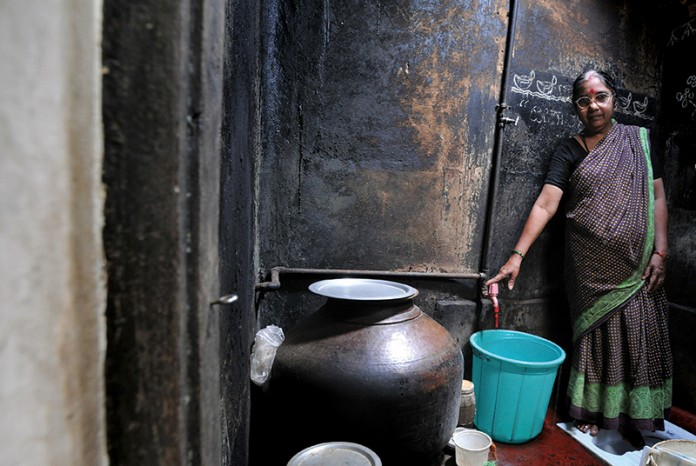Five hundred million people in South Asia still do not have access to a permanent water supply. James Workman highlights how three Indian cities have adopted a big bang approach to transform the lives of their citizens

If water utilities provide the lifeblood of cities, then a lack of supply means lives and livelihoods are at risk. Intermittent water supply (IWS) afflicts cities across Latin America, Africa and the Middle East butit affects one region most of all. “We have no town or city in South Asia [home to 500 million urban citizens] with a 24/7 service or WHO-standard water quality,” says Arjun Thapan, chair of WaterLinks, a regional network of water operators in Asia-Pacific. In India, non-revenue water degrades system operations until an intermittent water supply flows, on average, no more than 4.5 hours per day. The estimated losses from urban systems, nationwide, add up to US$2 billion a year [see Figure 1].
Fig. 1 Supply hours for water in different Indian cities

To appreciate intermittent water supply, imagine if your computer locked up every day, without warning and at variable times. Unable to afford enough storage for your work, documents and emails get erased or remain incomplete, and you waste hours of your time waiting to reconnect. Week after week this nightmare reoccurs, with no end in sight. You can’t switch systems because there’s no alternative. As well as lost productivity, society suffers the randomness of existence and trust breaks down.
We have no town or city in South Asia with a 24/7 service or WHO- standard water quality
Some water professionals claim that adapting to an intermittent supply, while regrettable, remains the cheapest solution for consumers, since limited access leads to more frugal demand, minimal waste and more efficient use. They ignore the opportunity costs of coping, and the lost time from sickness due to increases in waterborne disease.
[see Figure 2]
Fig 2. The coping costs of intermittent water supply in India


“Ironically, IWS water often risks becoming contaminated and the cost in time often exceeds what wealthier consumers pay for water from house connections,” says Bambos Charalambous, chair of the International Water Association’s specialist group on intermittent water supply. “Coping costs provide a lower bound to willingness-to-pay for water but are rarely quantified. Even those that argue that water should be provided free from public taps do not realise the significant economic costs in terms of time spent carrying water.”
He highlights the close link between intermittent supply and water loss. Pressure flux compromises the network’s structural integrity. Pipe failures increase. Meters malfunction. Illegal connections spread. The network deteriorates to the point where it’s next to impossible to detect and fix leaks. That’s when water contamination escalates to public health issues.
“It is relatively easy to turn a 24/7 system to an intermittent supply,” says Charalmbous. “But it is very hard to do the opposite.”
Even those that argue that water should be provided free from public taps do not realise the significant economic costs in terms of time spent carrying water
Still, it is possible to achieve it. The transition demands coordinated efforts by regulators, utilities and consumers, starting with four components. Utilities must be willing to make changes in accountability to regain the social trust of consumers. Consumers, in turn, must agree to accept technical metering in exchange for a gradual increase in hours of supply. Metering allows financial recovery through tariff structures linked to performance incentives to save water. And governance reforms provide institutional backing for hard choices toward continuous supply.
Throwing money at assets will fail. Education programmes targeting utilities and consumers, however, can demonstrate the benefits of a 24/7 service over coping and health costs, according to Thapan, who adds: “I do not know of any utility or local government in Asia that actually does this.” Thapan says that multilateral institutions like the World Bank or Asian Development Bank (which employed him for years) are not pushing enough.
So what action is needed?
From the top down, governments, donors and banks must oblige utilities to invest in water recovery as a prerequisite to receiving financial support or climate adaptation funds. “If efficiency cannot be induced, it must be prescribed,” says Thapan.
From the bottom up, staff must be trained and equipped to build capacity within utilities. “Peer-to-peer learning helps build pride and a sense of professional purpose in a utility’s technical staff,” adds Thapan.
The southwestern state of Karnataka in India embraced similar approaches in Hubli–Dharwad, Belgaum and Gulbarga. All three cities have very similar characteristics, with supplies available roughly for only three hours every two days. In demonstration zones, workers replaced the broken network with new polyethylene pipes, and installed meters for all customers.
“This project was able to transition to 24/7 with a ‘big bang’ approach based on replacement of the complete distribution system,” explains Charlambous.
Only if we improve the health of India’s water supply system, can we expect that a better quality of life will follow for its citizens.








